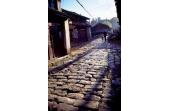Shuhe Ancient Town
- Things to do
-
- Photo(12)
- Tips&article(2)
- Make it Happen
- Map
-
loading...
Summary
Shuhe Ancient Town is the earliest habitations of Naxi ancestors, and it is also an important and well preserved post of the Ancient Tea Horse Route (an international trade route in Southwest China with the main vehicle is horse).
Features
1. Shuhe Ancient Town is one important constituent parts of Lijiang Ancient City which is one world cultural heritage sites in China.
2. It shows multiple cultural landscapes, including unique folk custom, historical relics and beautiful natural scenery.
3. Visitors can experience the simple and unsophisticated Naxi custom there.
Overview
Shuhe Ancient Town, also named Longquan Village (literally means Dragon spring village), is located is located in the north of Lijiang Ancient City. In Naxi language, Shuhe means ‘a village at the foot of peak’. As the earliest habitations of Naxi ancestors, Shuhe Ancient Town is regarded as the living specimen reflecting Naxi ancestors’ transition from agriculture civilization to commercial culture.
Similar to Lijiang Ancient City, Shuhe Ancient Town is surrounded by murmuring river and interlaced by smooth flagging. It is a compact village hidden in the forest and lying near the mountains and by the rivers. It is a more peaceful shorten version of Lijiang Ancient City.
Qinglong Bridge has a history of more than 400 years; it is the landmark building in Shuhe Ancient Town. The whole bridge was all built with stones, with 25 meters (82 ft) long, 4.5 meters (15 ft) wide, and 4 meters (13 ft) high. In early spring, the old bridge is decorated by verdant willows, which forms famous scenery in Shuhe.
Sifang Street, a market in the center of Shuhe village, covers an area about 250 square meters (2,691 sq. ft). It is very lively in market-days. Visitors can buy many leather products at the market. Surrounded the market are shops which all have archaic wooden facades. Travelers can choose and buy various handicrafts there like unique ornaments and costumes in ethnic style.
Walking along the street, about 100 meters (328 ft) away, you can find the fountainhead of the river surrounding the ancient town, it is a deep pool named Long Pool (Dragon Pool), from which the overflowing water winds through the village, and the bubbling sound can be heard miles away. Local people regard it as a sacred spring, and have built a temple called Beiquan Temple (North Spring Temple) to send their pray. The Master Leatherworking is enshrined in Sansheng Palace which is the most unique part of the temple.
Travel Essentials
Location: About 4 kilometers northwest from Lijiang Ancient City.
How to get there
1. Every day, there are shuttle buses departing from Lijiang Ancient City to Shuhe Ancient Town, which brings great convenience to travelers.
2. Visitor also can take a taxi to there, which takes about 20 minutes; while it will cost about 1.5 hours to get there by bike.
Best time to there: the peak period of visiting Shuhe Ancient Town is from May to October. Actually, Shuhe is worth to visit for all seasons, so if you do not want to be influenced by busy and crowd scene, avoiding that period must be a nice choice.
Nearby Attractions
Jade Spring Park
Lijiang Ancient City
Dongba Village
Related Readings
- Chinese History
- Check the Lijiang Tours or Customize a Tour in Lijiang
- Exotic China Tours: Travel along the Silk Road, venture into the deepest forest, visit hidden treasures, experience the lifestyle of local families and discover remote places that most tourists will never see.
- Explore Ancient Towns in China
Tips & articles
|
|










